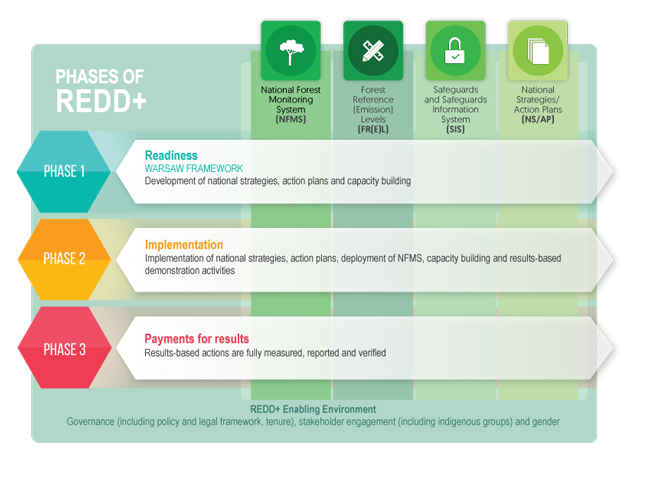Overview
The aim of REDD+ is to encourage developing countries to contribute to climate change mitigation efforts by: i) reducing greenhouse gas emissions (GHG) by slowing, halting and reversing forest loss and degradation; and ii) increasing removal of GHGs from the earth’s atmosphere through the conservation, management and expansion of forests.
Countries interested in REDD+ are required to progress through three phases, which are closely linked with one another (UNFCCC Decision 1/CP.16, paragraph 73):
- readiness phase, involving the development of national strategies or action plans, REDD+ mitigation actions, and capacity building;
- implementation of national strategies and results-based demonstration activities, enacting REDD+ actions and national strategies or plans that could involve further capacity building, technology development and transfer, and results-based demonstration activities;
- results-based actions that must be fully measured, reported and verified.

The following five REDD+ activities contribute to mitigation actions in the forest sector and have been globally agreed to:
- reducing emissions from deforestation
- reducing emissions from forest degradation
- conservation of forest-carbon stocks
- enhancement of forest-carbon stocks
- sustainable management of forests
These five activities can best be implemented – collectively or separately – through a package of coordinated REDD+ actions defined by each country and included in national strategies and action plans. These activities may also provide important climate change adaptation co-benefits. Adaptation refers to the resilience of ecosystems, as well as resilience of societies.
Where forests have not been degraded, people have enjoyed greater protection from natural disasters such as flooding and landslides. In coastal areas, mangroves can protect against storms and waves. Healthy forests also reduce vulnerability, offering food, shelter, medicine, and livelihood support to some of the world's poorest people.

